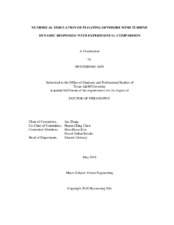| dc.description.abstract | Hywind, the world’s first operational Floating Offshore Wind Turbine (FOWT), is constrained by a delta mooring system to improve the yaw station-keeping capacity. In this study, a mooring line-simulation code in COUPLE-FAST was extended to simulate the dynamics of a delta mooring system using a Finite Element Method. The old mooring-simulation code in COUPLE-FAST was replaced with the extended code, and the new program is named as COUPLE-D-FAST. In this program, FAST calculates the aerodynamic, control and electrical system, and structural dynamic forces. COUPLE-D computes mooring and hydrodynamic forces, and then it calculates the global motions of FOWT using the wind forces computed using FAST.
COUPLE-D-FAST was then employed for the simulation of Hywind constrained by a taut delta mooring system. The simulated global motions and mooring lines’ tensions of Hywind were compared with the related measurements in a wave basin and the corresponding simulations obtained using a commercial code, FAST-OrcaFlex.
Several cases were simulated and compared with the measurements, which include free-decay tests, wind loads-only tests, wave loads-only tests, and wind combined with wave loads tests. Without empirical tunings on the yaw stiffness and damping of the Hywind’s mooring system, the simulated yaw free-decay responses showed excellent agreement with those of the model test. In general, the simulated motions and mooring lines’ tensions of Hywind showed satisfactory agreement with the experimental results in the cases of various wind and wave conditions. For the cases of wind combined with irregular wave loads, however, the simulated pitch of the FOWT near its resonant frequency was significantly smaller than the related measurements. This may result from the scaling issue between the prototype and its model that the aerodynamic damping follows the Reynolds number while the scale in the model test was based on the Froude number.
In this dissertation, it was found that COUPLE-D-FAST can reliably and accurately simulate the delta mooring system of Hywind. The accurate predictions of the delta mooring dynamics may make important contribution to the future design of FOWT. | en |


